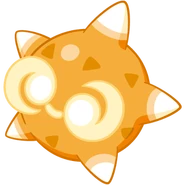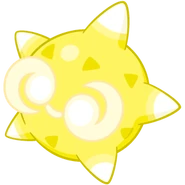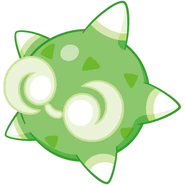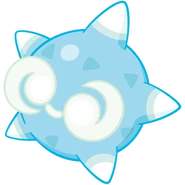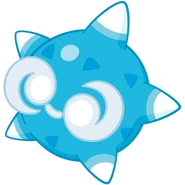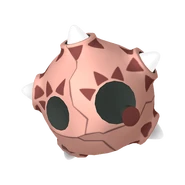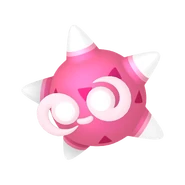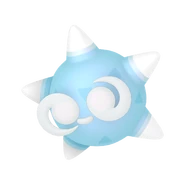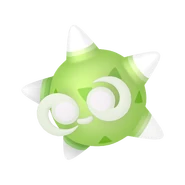Minior (Japanese: メテノ, Hepburn: Meteno) (MIN-ee-or[1]) is a dual Rock/-type Pokémon introduced in Generation VII.
Biology
Physiology
Minior resembles a levitating sentient meteorite with a light brown-colored body. It has two large black-colored circular eyes and five spikes protruding from its body. It also has triangular markings covering its body as well.
In its core form, Minior is smaller and has a perfectly spherical body. It eyes now are white and spiral-shaped. The color of its body is one of seven colors: red (pink), orange, yellow, green, blue, indigo, and violet.
Minior's physical lifespan is very limited. Once the core form comes out of the shell, it only has a short life to live until they die on a clear night. Its core becomes part of the universe if not returned to its Poké Ball quickly. This leaves the particles on the ozone layer of the Earth, in which Minior left behind upon its death to be absorbed by its natural predator, the Legendary Pokémon Rayquaza itself.
Behavior
Minior is thought to have originated from outer space, being created from absorbing large quantities of space debris. After absorbing too much debris, Minior crash lands to Earth.
Minior's rocky armor protects its vulnerable core inside. After revealing its core-shaped form, Minior will be able to attack more quickly due to its light weight.
The different colors of the core are based on what debris the Minior absorbs.
Natural abilities
Evolution
Minior does not evolve.
Game info
Locations
| Locations | ||
|---|---|---|
| Version(s) | Area(s) | Rarity |
| Sun and Moon | Mount Hokulani | Rare |
Pokédex entries
Stats
Meteor form
| Stats | |
|---|---|
| HP | |
| Attack | |
| Defense | |
| Sp. Atk | |
| Sp. Def | |
| Speed | |
| Total | 440
|
Core form
| Stats | |
|---|---|
| HP | |
| Attack | |
| Defense | |
| Sp. Atk | |
| Sp. Def | |
| Speed | |
| Total | 500
|
Learnset
Leveling
| LevelingGeneration VII | |||||||||
|---|---|---|---|---|---|---|---|---|---|
| Level | Move | Power | Accuracy | PP | Type | Cat. | |||
| 1 | Tackle | 40 | 100% | 35 | Physical | ||||
| 3 | Defense Curl | — | —% | 40 | Status | ||||
| 8 | Rollout | 30 | 90% | 20 | Physical | ||||
| 10 | Confuse Ray | — | 100% | 10 | Status | ||||
| 15 | Swift | 60 | —% | 20 | Special | ||||
| 17 | Ancient Power | 60 | 100% | 5 | Special | ||||
| 22 | Self-Destruct | 200 | 100% | 5 | Physical | ||||
| 24 | Stealth Rock | — | —% | 20 | Status | ||||
| 29 | Take Down | 90 | 85% | 20 | Physical | ||||
| 31 | Autotomize | — | —% | 15 | Status | ||||
| 36 | Cosmic Power | — | —% | 20 | Status | ||||
| 38 | Power Gem | 80 | 100% | 20 | Special | ||||
| 43 | Double-Edge | 120 | 100% | 20 | Physical | ||||
| 45 | Shell Smash | — | —% | 15 | Status | ||||
| 50 | Explosion | 250 | 100% | 5 | Physical | ||||
| Bold indicates this Pokémon receives STAB from this move. Italic indicates an evolved or alternate form of this Pokémon receives STAB from this move. | |||||||||
TM
| TMs, TRs, and HMs Generation VII | |||||||||
|---|---|---|---|---|---|---|---|---|---|
| TM/HM/TR | Move | Power | Accuracy | PP | Type | Cat. | |||
| TM04 | Calm Mind | — | —% | 20 | Status | ||||
| TM06 | Toxic | — | 90% | 10 | Status | ||||
| TM10 | Hidden Power | 60 | 100% | 15 | Special | ||||
| TM15 | Hyper Beam | 150 | 90% | 5 | Special | ||||
| TM16 | Light Screen | — | —% | 30 | Status | ||||
| TM17 | Protect | — | —% | 10 | Status | ||||
| TM20 | Safeguard | — | —% | 25 | Status | ||||
| TM21 | Frustration | — | 100% | 20 | Physical | ||||
| TM22 | Solar Beam | 120 | 100% | 10 | Special | ||||
| TM26 | Earthquake | 100 | 100% | 10 | Physical | ||||
| TM27 | Return | — | 100% | 20 | Physical | ||||
| TM29 | Psychic | 90 | 100% | 10 | Special | ||||
| TM32 | Double Team | — | —% | 15 | Status | ||||
| TM33 | Reflect | — | —% | 20 | Status | ||||
| TM37 | Sandstorm | — | —% | 10 | Status | ||||
| TM39 | Rock Tomb | 60 | 95% | 15 | Physical | ||||
| TM42 | Facade | 70 | 100% | 20 | Physical | ||||
| TM44 | Rest | — | —% | 10 | Status | ||||
| TM45 | Attract | — | 100% | 15 | Status | ||||
| TM48 | Round | 60 | 100% | 15 | Special | ||||
| TM57 | Charge Beam | 50 | 90% | 10 | Special | ||||
| TM62 | Acrobatics | 55 | 100% | 15 | Physical | ||||
| TM64 | Explosion | 250 | 100% | 5 | Physical | ||||
| TM68 | Giga Impact | 150 | 90% | 5 | Physical | ||||
| TM69 | Rock Polish | — | 100% | 20 | Status | ||||
| TM71 | Stone Edge | 80 | 100% | 5 | Physical | ||||
| TM74 | Gyro Ball | — | 100% | 5 | Physical | ||||
| TM77 | Psych Up | — | 100% | 10 | Status | ||||
| TM78 | Bulldoze | 60 | 100% | 20 | Physical | ||||
| TM80 | Rock Slide | 75 | 90% | 10 | Physical | ||||
| TM87 | Swagger | — | 85% | 15 | Status | ||||
| TM88 | Sleep Talk | — | —% | 10 | Status | ||||
| TM89 | U-turn | 70 | 100% | 20 | Physical | ||||
| TM90 | Substitute | — | —% | 10 | Status | ||||
| TM99 | Dazzling Gleam | 80 | 100% | 10 | Special | ||||
| TM100 | Confide | — | —% | 20 | Status | ||||
| Bold indicates this Pokémon receives STAB from this move. Italic indicates an evolved or alternate form of this Pokémon receives STAB from this move. | |||||||||
Breeding
This Pokémon learns no moves by Breeding.| Breeding Generation VII | |||||||||
|---|---|---|---|---|---|---|---|---|---|
| Move | Father | Power | Accuracy | PP | Type | Category | |||
|
Bold indicates this Pokémon receives STAB from this move. | |||||||||
Tutoring
| Tutoring Generation VII | |||||||||
|---|---|---|---|---|---|---|---|---|---|
| Move | Power | Accuracy | PP | Type | Cat. | ||||
| Endeavor USUM | — | 100% | 5 | Physical | |||||
| Gravity USUM | — | —% | 5 | Status | |||||
| Iron Head USUM | 80 | 100% | 15 | Physical | |||||
| Last Resort USUM | 140 | 100% | 5 | Physical | |||||
| Magnet Rise USUM | — | —% | 10 | Status | |||||
| Snore USUM | 50 | 100% | 15 | Special | |||||
| Stealth Rock USUM | — | —% | 20 | Status | |||||
| Telekinesis USUM | — | —% | 15 | Status | |||||
| Zen Headbutt USUM | 80 | 90% | 15 | Physical | |||||
| Bold indicates this Pokémon receives STAB from this move. Italic indicates an evolved or alternate form of this Pokémon receives STAB from this move. | |||||||||
Sprites
Core Forms
Red Core |
Black Core/Shiny |
Orange Core |
Yellow Core |
Green Core |
Light Blue Core |
Indigo Core |
Violet Core |
Appearances
Trivia
- Similarly to some other Pokémon, Minior is thought to originate from outer space.
- Currently, Cryogonal, Minior and Mew are the only genderless Pokémon that can learn Attract (although they can only learn Attract via TM), which would always fail when used, due to them being genderless.
- This is the first Pokémon species to have a very short lifespan (in mostly its core form) as of the Sun & Moon Season 2 anime adaption’s episode "Showering the World with Love!".
- Minior is tied with Alcremie for being in the most color groups, each appearing in six different groups.
- Minior has made an appearance in a level called Magmatic Sanctuary in a user-made level in the game Geometry Dash. The Pokémon appears as a boss at the end of the level, being in its Meteor Form at first, then later returning as an Orange Core.
Origin
Minior is based on a meteorite or the concept of "falling stars" (often called shooting stars). It is also similar to the Japanese candy konpeitō, which look like miniature multi-colored stars. It may also be based on gashapon capsules, small capsules received from machines that include random toys. Similarly to Minior's core needing to be opened to see which color it is, the toy inside can not be seen until the capsule is opened. Minior cores, with their happy expressions, multiple colors, and star-shaped bodies, somewhat resemble Lumas from the Mario series.
Etymology
Minior is a portmanteau of mini, meteor, junior, and possibly core.
In Japanese name, Meteno, is a mixture of meteor and nano. It may also incorporate 天 (ten, sky or heaven), 天王星 (Tennōsei, the planet Uranus), and/or 天文学 (tenmongaku, astronomy).
Names in other languages
- Japanese, French, and German: Meteno
- English, Spanish, and Italian: Minior
Gallery
References
- ^ Silvestri, Cris (2018). Pokémon: Super Deluxe Essential Handbook [Book]. p. 324. Scholastic. ISBN 978-1338230895.
| |
|---|---|
| |
| |
| |
| See also | |
| Generation VII | |
| Characters · Locations | |||||||||||||||||||||||||||||||||||||||||||||||||||||||||||||||||||||||||||||||||||||||||||||||||||||||||||||||||||||||||||||
| |||||||||||||||||||||||||||||||||||||||||||||||||||||||||||||||||||||||||||||||||||||||||||||||||||||||||||||||||||||||||||||
| See also | |||||||||||||||||||||||||||||||||||||||||||||||||||||||||||||||||||||||||||||||||||||||||||||||||||||||||||||||||||||||||||||
| Pokédex | |||||||||||||||||||||||||||||||||||||||||||||||||||||||||||||||||||||||||||||||||||||||||||||||||||||||||||||||||||||||||||||
| Characters · Locations (Paldea · Kitakami · Terarium) | |||||||||||||||||||||||||||||||||||||||||||||||||||||||||||||||||||||||||||||||||||||||||||||||||||||||||||||||||||||||||||||||||||||||||||||||
| |||||||||||||||||||||||||||||||||||||||||||||||||||||||||||||||||||||||||||||||||||||||||||||||||||||||||||||||||||||||||||||||||||||||||||||||
| See also | |||||||||||||||||||||||||||||||||||||||||||||||||||||||||||||||||||||||||||||||||||||||||||||||||||||||||||||||||||||||||||||||||||||||||||||||
| Pokédex | |||||||||||||||||||||||||||||||||||||||||||||||||||||||||||||||||||||||||||||||||||||||||||||||||||||||||||||||||||||||||||||||||||||||||||||||





